
Unravelling
Varanasi: Vinayan's photographic exhibition
- Padma Jayaraj,
Thrissur
e-mail: padmajayaraj@gmail.com
June
4, 2009
KR Vinayan’s photographic
exhibition, Sublime to Ethereal, at Durbar Hall Art Gallery, Kochi,
Kerala, brought Varanasi to those who could not make a pilgrimage to the
holy city. For the past 3000 years the people of the subcontinent, have
flocked its streets in search of life, knowledge, and nirvana. The
sacred city is the ultimate pilgrimage destination for the devout Hindu
even today. Vinayan’s camera travels from dawn to dusk, a photographic
expedition through its different terrains absorbing its traditions, its
life, its complexities, and contradictions.
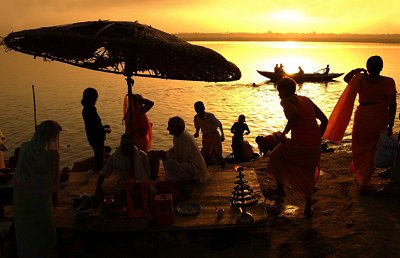 The very first
shot introduces you to the poetry of Kasi. Silhouetted against the Ganga
drenched in golden dawn, a crowd has gathered to perform ceremonial rituals.
Most of them have come to perform the last rites to a dear departed one
to ensure liberation. One is there to recite the Gayatri mantra,
prayers to the Sun, life sustaining light and energy. Another perhaps to
pay a tribute to the primordial waters, the source of all life. In the
background a boat carrying pilgrims ply through its waters. Older than
legends, older than traditions, Varanasi, one of the oldest cities in the
world still retains its mystique.
The very first
shot introduces you to the poetry of Kasi. Silhouetted against the Ganga
drenched in golden dawn, a crowd has gathered to perform ceremonial rituals.
Most of them have come to perform the last rites to a dear departed one
to ensure liberation. One is there to recite the Gayatri mantra,
prayers to the Sun, life sustaining light and energy. Another perhaps to
pay a tribute to the primordial waters, the source of all life. In the
background a boat carrying pilgrims ply through its waters. Older than
legends, older than traditions, Varanasi, one of the oldest cities in the
world still retains its mystique.
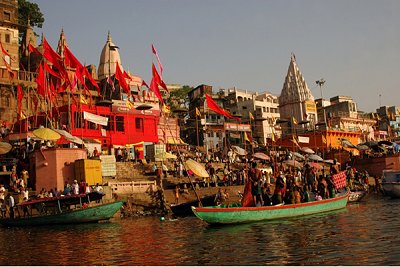 The photographer
takes a look at Varanasi in the Indo-Gangetic plains. Situated amidst the
confluence of the two tributaries, Varun and Asi, the Ganga is the lifeline
of Varanasi. Two pictures of its banks, distinct and different from
each other: one where the populous India bursts and the other deserted,
yet filled with the golden showers of mustard fields in bloom, symbolize
the persona of the country.
The photographer
takes a look at Varanasi in the Indo-Gangetic plains. Situated amidst the
confluence of the two tributaries, Varun and Asi, the Ganga is the lifeline
of Varanasi. Two pictures of its banks, distinct and different from
each other: one where the populous India bursts and the other deserted,
yet filled with the golden showers of mustard fields in bloom, symbolize
the persona of the country.
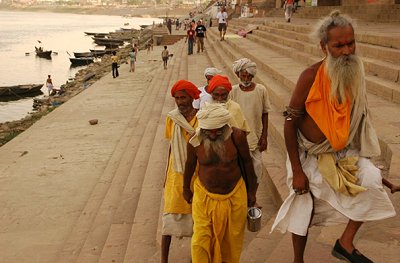 Sages of every
hue dot the river banks amidst the devout from the East, amidst the curious
from the West, amidst cows and dogs that search for food. Indeed from the
time of the Rig Veda, down to Buddhist and Jain heydays, Varanasi attracted
seekers of knowledge both spiritual and temporal. Even today it is the
citadel of learning with Benares Hindu University where many foreigners
pursue their studies. The place is still a seat of classical music and
dance.
Sages of every
hue dot the river banks amidst the devout from the East, amidst the curious
from the West, amidst cows and dogs that search for food. Indeed from the
time of the Rig Veda, down to Buddhist and Jain heydays, Varanasi attracted
seekers of knowledge both spiritual and temporal. Even today it is the
citadel of learning with Benares Hindu University where many foreigners
pursue their studies. The place is still a seat of classical music and
dance.
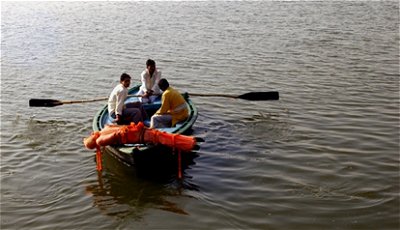 More than anything
else, Death haunts the place. A series of pictures show the ever burning
ghats, day in and day out. Jal-samadhi, watery burial, is another
tradition cast for the sages and the poor. People from far off places bring
the ashes of the dead to be immersed in its waters.
More than anything
else, Death haunts the place. A series of pictures show the ever burning
ghats, day in and day out. Jal-samadhi, watery burial, is another
tradition cast for the sages and the poor. People from far off places bring
the ashes of the dead to be immersed in its waters.
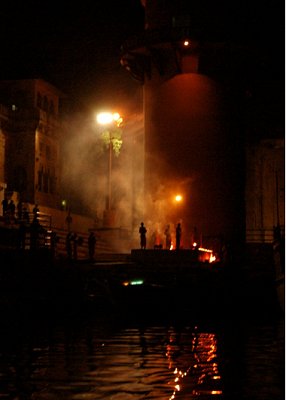 The hapless old
walk into their sunset here. Traditionally the old sought nirvana
at the feet of Kasi Viswanath. Changing time and tide has corrupted that
practice. Many come as a last resort. That the old are pushed to the edge
by the callous young is a sad commentary on the inhumanity practiced in
the name of traditions.
The lens man documents
lesser known rituals. It is the story of a mother from a village who promised
to crawl all the way from her home to the River Ganga to take a dip, if
and when her daughter got married. Indeed the River has bestowed boons
from time immemorial. The mother takes the dip in its blessed waters as
the newly wedded gaze on.
The hapless old
walk into their sunset here. Traditionally the old sought nirvana
at the feet of Kasi Viswanath. Changing time and tide has corrupted that
practice. Many come as a last resort. That the old are pushed to the edge
by the callous young is a sad commentary on the inhumanity practiced in
the name of traditions.
The lens man documents
lesser known rituals. It is the story of a mother from a village who promised
to crawl all the way from her home to the River Ganga to take a dip, if
and when her daughter got married. Indeed the River has bestowed boons
from time immemorial. The mother takes the dip in its blessed waters as
the newly wedded gaze on.
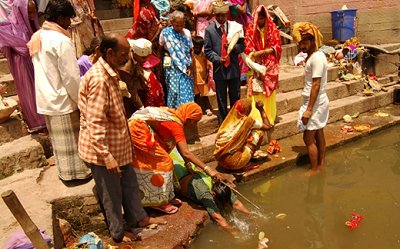 The artist seems
to be fascinated by the ethos of women. A forsaken old woman trying to
accept her fate clinging on to her faith for strength is set against her
younger counterpart from the West taking refuge in drugs: two figures etched
on the banks of Ganga is a touching portrayal.
The artist seems
to be fascinated by the ethos of women. A forsaken old woman trying to
accept her fate clinging on to her faith for strength is set against her
younger counterpart from the West taking refuge in drugs: two figures etched
on the banks of Ganga is a touching portrayal.
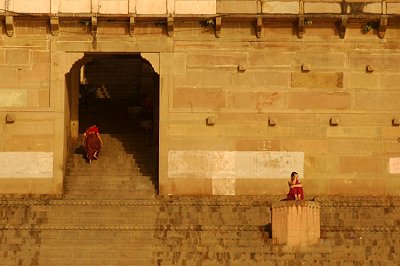 The artist captures
bright moments as well. Bride and bridegroom, gaily decked come to the
temples of the Ganga. The Ganga aarti is a spectacular sight: a symphony
of whirling lights held by the priests, sounds of the drum and gong, temple
instruments, and a chorus of age old chants reverberating twilight calm,
and lighted diyas on leafy plates adrift on the river like a Milky
Way.
The artist captures
bright moments as well. Bride and bridegroom, gaily decked come to the
temples of the Ganga. The Ganga aarti is a spectacular sight: a symphony
of whirling lights held by the priests, sounds of the drum and gong, temple
instruments, and a chorus of age old chants reverberating twilight calm,
and lighted diyas on leafy plates adrift on the river like a Milky
Way.
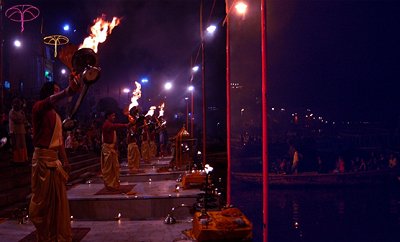 Cyclists over
a floating bridge across the river, speaks of technological innovations
inherited down the line. The picture of Muslim artisans at work, weaving
the famous Benaras silk saris, completes a positive social reality in this
troubled times of religious conflict in the subcontinent.
Cyclists over
a floating bridge across the river, speaks of technological innovations
inherited down the line. The picture of Muslim artisans at work, weaving
the famous Benaras silk saris, completes a positive social reality in this
troubled times of religious conflict in the subcontinent.
As you finish
your round, you stand in front of the picture of Ustad Bismillah khan with
his shehnai.
The show is
curated in such a way that the first and the last photographs are juxtaposed
to give a different dimension. The Ganga in her different moods forming
the backdrop of each picture, implicitly or explicitly, is an ever present
phenomenon. And the silhouetted figures acquire the dimension of characters
in a shadow play that enact the eternal saga of human woes on the banks
of primeval waters. Racial memories evoke the murmuring Ganga down the
ages. Your spirit listens to the ethereal strains from shehnai, unheard
songs of life, love, loss, and death. …
“’What is better
than doing Riyas on the banks of the Ganga, watching the crowds of Benaras
and having the prasad of the Viswanathji ka mandir…..’ - the words of Bismillah
Khan, inspired me to visit Varanasi and prompted me to work there,” says
the artist. And the show is dedicated to Ustad Bismillah khan, the living
legend of Indian music.
The photographs
in different tones are natural without any touching for artistic effect.
Vinayan whose passion is still photography is to receive an award from
Kerala Lalithakala Academy this year.
Padma
Jayaraj is a freelance writer and a regular contributor to www.narthaki.com |









